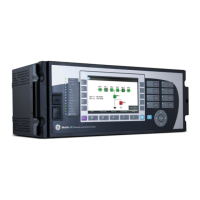L90 LINE CURRENT DIFFERENTIAL SYSTEM – INSTRUCTION MANUAL 10-1
L90 Line Current Differential System
Chapter 10: Theory of operation
Theory of operation
This chapter outlines advanced information on operation.
10.1 Overview
10.1.1 L90 design
All differential techniques rely on the fact that under normal conditions, the sum of the currents entering each phase of a
transmission line from all connected terminals is equal to the charging current for that phase. Beyond the fundamental
differential principle, the three most important technical considerations are data consolidation, restraint characteristic,
and sampling synchronization. The L90 uses new and unique concepts in these areas.
Data consolidation refers to the extraction of appropriate parameters to be transmitted from raw samples of transmission
line phase currents. By employing data consolidation, a balance is achieved between transient response and bandwidth
requirements. Consolidation is possible along two dimensions: time and phases. Time consolidation consists of combining
a time sequence of samples to reduce the required bandwidth. Phase consolidation consists of combining information
from three phases and neutral. Although phase consolidation is possible, it is generally not employed in digital schemes,
because you want to detect which phase is faulted. The L90 relay transmits data for all three phases.
Time consolidation reduces communications bandwidth requirements. It also improves security by eliminating the
possibility of falsely interpreting a single corrupted data sample as a fault.
The L90 relay system uses a new consolidation technique called “phaselets.” Phaselets are partial sums of the terms
involved in a complete phasor computation. The use of phaselets in the L90 design improves the transient response
performance without increasing the bandwidth requirements.
Phaselets themselves are not the same as phasors, but they can be combined into phasors over any time window that is
aligned with an integral number of phaselets (see the Phaselet Computation section in this chapter). The number of
phaselets that must be transmitted per cycle per phase is the number of samples per cycle divided by the number of
samples per phaselet. The L90 design uses 64 samples per cycle and 32 samples per phaselet, leading to a phaselet
communication bandwidth requirement of two phaselets per cycle. Two phaselets per cycle fits comfortably within a
communications bandwidth of 64 Kbaud, and can be used to detect faults within a half cycle plus channel delay.
The second major technical consideration is the restraint characteristic, which is the decision boundary between situations
that are declared to be a fault and those that are not. The L90 uses an innovative adaptive decision process based on an
online computation of the sources of measurement error. In this adaptive approach, the restraint region is an ellipse with
variable major axis, minor axis, and orientation. Parameters of the ellipse vary with time to make best use of the accuracy
of current measurements.

